Last weekend, 30-year-old Anna Frost of New Zealand won the December 3, 2011, North Face Endurance Challenge 50-mile Championship in a course record-setting time of 6 hours, 56 minutes, earning the $10,000 prize. Nearly three hours later, I ran across the finish line in 9 hours, 50 minutes, placing 19th among the women and 122nd overall.
I was elated to finish after having seriously considered dropping out midway, yet disappointed it took me 45 minutes to an hour longer than anticipated. My legs cramped, toes bruised, gut blew up, skin chafed. My mind sunk into a funk of negativity and aimlessness during the worst miles of the day. But strong running and a steely determination book-ended those dark middle miles. At the finish area and throughout this past week, I pondered questions about what went right and wrong, reflecting on how much I learned in a single day—and how much I still have to learn.
Lesson Number One from this race: You can read books on ultrarunning, talk to ultrarunners and follow the sport for years, as I have done, but to actually learn how to do it, you have to experience it. There are no shortcuts, no substitutes for logging the miles on your own legs. This was, in my mind, only my third ultra—my third 50-miler—since I’m of the minority opinion that the ten 50Ks I’ve done don’t really count as ultras. Most decent marathoners can complete 50K (31 miles) without altering their training, whereas 50-milers demand a significantly different type of training and race-day plan.
I didn’t think I had much in common with the incredible Anna Frost, because she’s totally out of my league—training virtually full time, an international sponsored athlete—until I watched the impressive video below that highlights some of the runners in the race.
“I’m a total novice to ultrarunning,” Anna says in the interview, “and there’s so much to learn. I don’t know if you ever stop learning in something like this. … Ultras scare me, they really do. I guess it’s ’cause it’s the unknown.”
Well put, Anna, and I’d say the same thing.
The day began auspiciously. I woke up in the middle of the night, left my house at 3:15, and didn’t get lost or delayed getting to the starting area by Fort Barry (phew!). At 5 a.m., I took off running under a dazzling starry sky in the dark and rugged expanse of the Marin Headlands. I was one of 350 runners, and about 80 percent of the field was male (only 65 of the 317 who finished were female). Together we created a bobbing line of headlamp beams that looked like a garland of holiday lights strung up on the hillside’s switchbacks, which climb 1,000 feet in the first two miles. Strong, howling blasts of wind muffled the sound of runners’ heavy breathing and the rhythmic crunch of dirt underfoot.
Fueled by adrenaline yet disoriented by darkness and lack of sleep, part of me felt wide awake and acutely aware of the sensations, but the other part felt half-asleep and dreaming. I couldn’t think very clearly, so I just went with the flow.
An hour and a half later, we climbed a 400-foot fire road out of Tennessee Valley that leads to the winding, single-track Coastal Trail and plunges down to Muir Beach. The glow of sunrise illuminated the coastline’s foamy surf in the coves far below. A glance over my left shoulder revealed the sun rising behind San Francisco. The city’s bejeweled landscape of buildings with windows caught the light and sparkled like facets on a diamond. The pink-tinged, cloudless sky promised perfect weather for the day.
The ideal trail conditions and achingly beautiful scenery felt like a gift—a golden opportunity—for some runners to have their best race ever. But I kind of already knew—or was creating a self-fulfilling prophecy—that this wouldn’t be a great race day for me, because I wasn’t really racing. I wasn’t in the shape to race (that’s another story, but suffice to say my running in September and October was less than ideal), so I coached myself to run conservatively and “just enjoy it.” As detailed in my last post, I didn’t have goals to beat anybody in particular or to hit aid stations at certain times; I only hoped to finish close to 9 or 9:15 hours, given that my previous two 50-milers took around 8:30 and this was a harder course.
Lesson Number Two: I learned that I need goals and structure in an ultra-distance race. Otherwise, I start asking myself, “What am I doing out here? Why bother?” Without a reason to run aggressively and lacking a plan to execute, my running turns lackluster. Then it becomes, “Why not walk?” which flirts with, “Why not drop out?” I’m learning that I like to race—even if, or especially if, it’s racing myself to beat a better time rather than racing other women. Racing makes me a better runner and enhances the thrill (e.g. see this year’s Ohlone 50K report).
I actually tackled the switchbacks pretty well on the give-’em-the-finger climb to Cardiac aid station, between Miles 15 and 18. So far, so good. I felt a boost upon seeing my friend Jeffery Rogers volunteering on the trail at this portion. (He had been out since around 3 a.m. to run the course and check the markings, and he discovered that some jerks had removed the markings on a long stretch to Muir Beach, which he replaced. Volunteers like him are the unsung heroes of these events.)
So there I was at the 18-mile aid station, psyched for the out-and-back 8-mile stretch ahead, because this segment of single track represented the one portion of the course that would be utterly new to me, and I thought it would be “fun” to discover it. From the Pantoll Ranger Station the route follows the Matt Davis Trail and, for a while, I celebrated the woodsy, windy way. Then the trail exited the forest, burst open on the hillside, and within about a mile I discovered that I needed to dodge oncoming runners on a narrow stretch with a drop-off. Super fast runners from the lead pack charged at me since they were coming back on this out-and-back portion. Etiquette dictates that those going out—the slower ones—yield to the speedsters coming back, so with each runner I faced, I paused and leaned into the uphill slope to give the oncoming runners clearance to pass.
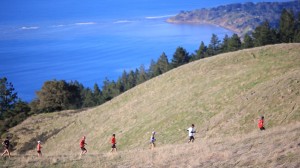
I'm not sure exactly where on the course this stretch of trail is, but it looks similar to the single-track out-and-back section when runners dodged each other in opposite directions. (photo courtesy Hawkeye)
This out-and-back stretch to the McKennon Aid Station trashed me mentally and drained me physically. I got inordinately PO’ed at the situation of having to pause every ten seconds or so and yield in a game of chicken that tweaked my knee by leaning and dodging laterally. This unknown trail segment that I looked forward to turned out to be a big pain. Plus, it was more discouraging than inspiring to see the front-runners, because they seemed so far ahead and underscored how mediocre I felt.
I got to the 23-mile aid station, which was the turnaround point on the out-and-back, and clocked more time in the porta-potty. My bathroom stops proved another source of distraction and delay throughout the day. First I was constipated, and then I wasn’t, and it’s debatable which was worse. This is shitty, I thought. I’m in the dumps. What a crappy run. I’m pooped.
I ran down toward Stinson Beach, legs screaming, and hit a low point mentally during which I stopped and stood on the side of the trail. My excuse was I needed to fish a salt pill out of my pack, but really I just wanted to stand still and assess the situation. I truly felt that I didn’t want to be out there, trashing my legs, and I was lonely and bored. I had seen enough of the scenery. I wished I had brought my iPod after all, which I left at home, thinking I didn’t want to fuss with it. I had run a marathon and that seemed enough. My past two 50-milers hit a low point mentally and physically at the midpoint, too, so I tried to tell myself I’d get better, but I couldn’t push away thoughts of dropping out at the next aid station.
A pack of guys came charging down the trail and saved me. Without thinking, I quickly jumped back into action and ran behind them, as if hitching my caboose to their train. They were talking, laughing and running fast. I didn’t say anything; I just listened and concentrated on going fast enough to keep up with them, not wanting to be left behind.
Lesson Number Three: I run best when running with others, and I crave the camaraderie. I could have used a pacer out there to keep me company and help me stay focused.
I tried to pull myself together at the Mile 28 aid station. Rick Gaston snapped the following picture of me there, which cracks me up, because I look like a drama queen dodging paparazzi. “No pictures, please, I’m about to pass out and might crap my pants!”
The next five-mile stretch climbs about 1400 feet back up to Cardiac Aid Station on the famous Dipsea trail, which means repeated stair climbs and technical footing through the dense woods. I was so slow! But so was everyone else around me. I encouraged myself by remembering the time I ran the Double Dipsea with Morgan on our anniversary run, and by thinking of my friends who ran the 28-mile Quad Dipsea the prior weekend. “I’ve done this before, I can do it again” became my mantra.
At Cardiac, which was Mile 33, I encountered my longtime friend Adam Ray. He works as a North Face ambassador and course marshal for the event, so he had been going all over the course all day to check on things. Adam has been present at all pivotal moments in my life since adolescence, so I felt incredibly lucky to run into him there.
As he listened, I spewed all my problems and all my weaknesses, all the details on my pooping and blistering and bonking. I said the run sucked and I sucked and I seriously would like to drop out. He looked sympathetic but slightly bemused. I’m pretty sure he was trying not to laugh. I knew he was thinking, “You big dummy, this is what you signed up for, what did you expect?” But all he said was, “Just take it aid-station-to-aid-station. Run to the next one, and then see how you feel.”
It’s as simple as that.
I made steady progress on the next section through the woods and blazed through the next aid station, pausing only to say hi and thanks to my friend Eric Ellisen, who was volunteering, before heading down to Muir Beach (Mile 42.5). I actually was psyched to start the big climb, which shoots up 1000 feet in only about two miles, because I felt more confident about this portion. Sure enough, while pretty much every runner in this stretch suffered, I managed to feel stronger and pass many. The problem came on the back side, when the trail descends sharply back down to Tennessee Valley. In past races that have steep downhill stretches late in the race, I have excelled in getting my legs to turn over and fly down the hill. No such luck here—my creaky, wobbly legs couldn’t go with the flow. It was my turn to be the one getting passed.
At Tennessee Valley (Mile 45.5), I had a drop bag waiting with my handheld water bottle, so I could dump my hydration pack and run the last 10K with just one bottle and no gear. (The course is actually a little over 51 miles, so we had about 6 miles to go.) It felt so liberating to take off the pack that had been chafing my back and weighing me down.
Lesson Number Four: I don’t need to carry so much gear in an ultra event. I had loaded up my pack as I normally do for long training runs, but given the frequency of aid stations, I didn’t need to carry so many snacks, packets of Gu, gloves and arm warmers, and a heavy reservoir of water in the pack. Since it wasn’t a very hot day, I probably could have gotten along with one hand-held bottle and the little pockets in my shorts to carry a couple of gels.
I looked at my watch—approaching 9 hours—and realized I would need to push to break 10 hours, given that the last uphill climb meant a pace slower than 10 minutes/mile. I never thought it would take me 10 hours to do this course, and my ego didn’t want to let that happen. I also rekindled my competitive streak, not wanting to be passed by a woman I had been leapfrogging with all day.
Having a goal and the finish in sight, I ran the best 10K of the day—strong and steady up the last long climb with only a few deliberate, limited walking breaks, and the best I could manage on the downhills. I ached all over and felt caught in a slow-motion bad dream during the final two miles, but I recalled advice a coach once gave, “Even when you feel bad, try to look good.” I admit that with all the spectators toward the finish, I wanted to look good, which in turn improved my form from hunched-over knuckle-dragger to respectable runner mustering something close to a sprint.
You might think the best part of finishing is crossing the finish line, which often is true. I finished—I didn’t quit—and the pride and relief I felt from that fact is the best lesson of the day: It’s worth it in the end. I don’t ever want to DNF (did not finish) unless I have a legitimate medical excuse. And I finished better than average, at 9:50, while the average time of the 317 finishers was 10:25. Not too shabby after all.
But for me, it turned out that an even better part of finishing this event was talking to all the elite athletes out there, and seeing and hearing about how they coped with their disappointments. I enjoyed meeting and talking to Geoff Roes (whose camp in Alaska I’m attending next summer), Hal Koerner (who remembered me from our Ashland running last summer), Rickey Gates (featured in the video above) and others. Those guys train so hard, and they had a shot at the top 3 to win significant prize money, but it wasn’t their day. Yet they were smiling, they were friendly, they didn’t seem to have any regrets, and from them and others like them I gained a great deal of inspiration.
I hung out with other people I recognized and hadn’t seen in a long time, and I watched and admired my friend Christine Chapon working so tirelessly as the event’s volunteer coordinator. Then Dean Karnazes recognized me and gave me a big hug, which was a surprise and special feeling, since I had been reading his books and studying his life for the past couple of months.
The good vibe at the finish strengthened bonds and made friends out of strangers, and I was so grateful to be a part of it—so happy to have earned it by going the distance.
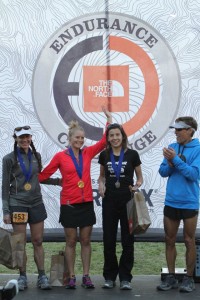
Congratulations to the top women (L-R): Joelle Vaught (3rd), Anna Frost (1st) and Ellie Greenwood (2nd) with event host Dean Karnazes. (photo courtesy The NFEC Facebook page)
A few other NFEC50 race reports and related articles I recommend:
- Dakota Jones on iRunFar.com (2nd place male)
- Geoff Roes (champion ultrarunner, 5th place finish)
- Jen Benna (10th place female)
- John Nguyen (mid-pack perspective; it took him 13+ hours)
- Anna Frost (female winner) pre-race interview and her own blog post on coming back from a stress fracture and the “Female Athlete Triad” of health problems caused by too-low body fat and over training.
Here’s one more video I can’t get enough of, which shows the amazing race between the front two guys:
One final note: I didn’t publish any photos of me along the course because I thought the event photos taken of me looked awful and weren’t worth the price, but for my mom and dad who will read this and anyone else who’s curious, you can see the race photos at this link and search my bib number 233.

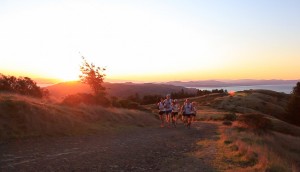
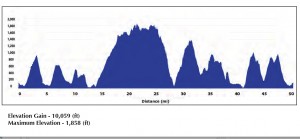
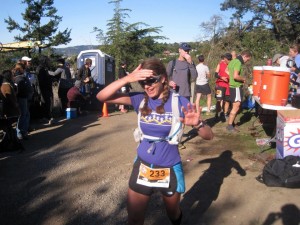
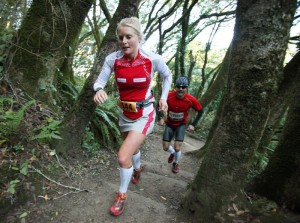
“My legs cramped, toes bruised, gut blew up, skin chafed. My mind sunk into a funk of negativity and aimlessness during the worst miles of the day.”
Sounds like an ultra to me! Still, with the fear of passing out and crapping yourself, you ran a solid time, faster than some of my male friends from Colorado altitude last year.
Fun report.
tim
You should be proud. Get those photos of you up there. you did it. You entered…you raced…you battled physjcally and mentally and you won. you finished. no one can take that away from you. Keep on keeping on Sarah.
Wow, thank you, Anna — how great to get this comment from you — thank you so much! More proof that Kiwis are incredibly nice :-).
If every race went smoothly, it wouldn’t be as rewarding to finish. I’m a bit distressed that you don’t count your Diablo 50K as an ultra… Just another easy training run, I suppose.
Oh goodness, friend, what a day you had. Oof, it pained me to read this report. Here’s the deal, though, you did it. And, perhaps most significantly, you did it on a day when you weren’t feeling your best. You acquired some new mental toughness on this race that will prove useful elsewhere in running and life. Keep your head up and be proud.
Also, it was so nice to spend some time with you while we were in your neck of the woods.
Sarah- you did a great job out there. It’s a tough course, no doubt about it. I think the greatest thing about ultras are the lows are what make the highs so amazing. I would also say regardless of time or place, we are all struggling at one point or another out there. Congrats on getting to the finish in good form.
WOW! What a challenge the day was. It boggles the mind to think of accomplishing what you do;I am sooooo proud of you and hope you are proud of you, too. Way to go! You’re amazing!
That was an awesome and hilarious post, Sarah! Loved it, might be your best from what I read at least:)
I’m honored to be mentioned (and linked in) to your report! You looked awesome out there. I still think of you as an elite ultra runner. In the ultra world, you’re like a sub-3 hour marathoner. And I think you still have a lot of potential to tap into! If you felt under trained going into this race, I can’t wait to see you when you feel fully trained! And you get to rub elbows with all those elite runners! Congrats again on a fine race, finish, and report! (I’ll add a link to your race report in mine as well!)
I really like:
….“You big dummy, this is what you signed up for, what did you expect?
Congrats on the great finish. It was a perfect day for a race in the hills.